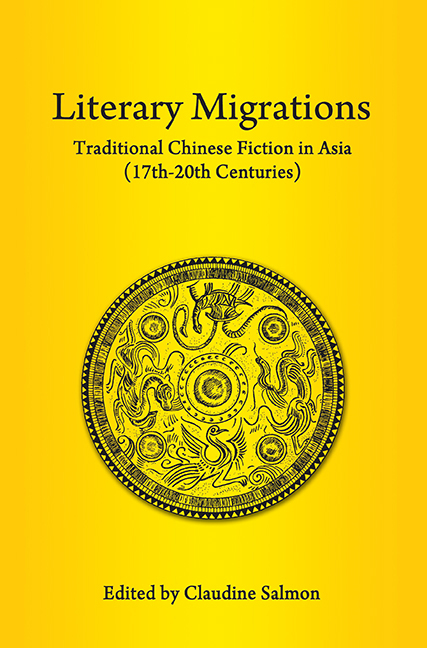Book contents
- Frontmatter
- Contents
- FOREWORD
- Dr Salmon as I Know her
- Preface to Reprint Edition
- Acknowledgements
- INTRODUCTION
- PART I KOREA AND JAPAN
- PART II MAINLAND NORTHEAST ASIA
- PART III MAINLAND SOUTHEAST ASIA
- PART IV INSULAR SOUTHEAST ASIA
- 10 A Note on Javanese Works Derived from Chinese Fiction
- 11 Malay Translations of Chinese Fiction in Indonesia
- 12 Writings in Romanized Malay by the Chinese of Malaya — A Preliminary Inquiry
- 13 Lie Sie Bin Yoe Tee Hoe — Six Malay/Indonesian Translations of a Chinese Tale
- 14 Liang Shanbo yu Zhu Yingtai — A Chinese Folk Romance in Java and Bali
- 15 Translations of Chinese Fiction into Makassarese
- 16 Sam Pek Eng Tay — A Chinese Love Story in Madurese
- 17 Post-war Kung Fu Novels in Indonesia — A Preliminary Survey
- Bibliography
- Author, story-teller and translator index
- Title index
- List of Plates
- Contributors
- Plate section
14 - Liang Shanbo yu Zhu Yingtai — A Chinese Folk Romance in Java and Bali
from PART IV - INSULAR SOUTHEAST ASIA
Published online by Cambridge University Press: 21 October 2015
- Frontmatter
- Contents
- FOREWORD
- Dr Salmon as I Know her
- Preface to Reprint Edition
- Acknowledgements
- INTRODUCTION
- PART I KOREA AND JAPAN
- PART II MAINLAND NORTHEAST ASIA
- PART III MAINLAND SOUTHEAST ASIA
- PART IV INSULAR SOUTHEAST ASIA
- 10 A Note on Javanese Works Derived from Chinese Fiction
- 11 Malay Translations of Chinese Fiction in Indonesia
- 12 Writings in Romanized Malay by the Chinese of Malaya — A Preliminary Inquiry
- 13 Lie Sie Bin Yoe Tee Hoe — Six Malay/Indonesian Translations of a Chinese Tale
- 14 Liang Shanbo yu Zhu Yingtai — A Chinese Folk Romance in Java and Bali
- 15 Translations of Chinese Fiction into Makassarese
- 16 Sam Pek Eng Tay — A Chinese Love Story in Madurese
- 17 Post-war Kung Fu Novels in Indonesia — A Preliminary Survey
- Bibliography
- Author, story-teller and translator index
- Title index
- List of Plates
- Contributors
- Plate section
Summary
On the evening of 17 January 1982, before a large but makeshift bamboo and thatch theatre building in the palace square of Yogyakarta, Central Java, an aggressive gang of ticket touts was busy pushing tickets for the night's performance. Even at more than double the box-office prices, business was brisk. The performance was by the renowned ketoprak theatre company “Siswo Budoyo” from Tulungagung in East Java, and on this night the 2,000 patrons who packed the theatre would see one of the most popular stories in the ketoprak repertoire, the story of Sam Pek and Eng Tay. The audience was Javanese, the players were Javanese, the performance was in the Javanese language and the theatrical genre was that of ketoprak, a uniquely Javanese form in which plays on historical themes are acted in semi-realistic fashion with largely improvised dialogue on a proscenium stage to the accompaniment of gamelan music. But costumes and stage sets, although heavily Javanized, were still recognizably Chinese, and the story, for all its twists and turns, was still the celebrated Chinese romance of the butterfly lovers, Liang Shanbo and Zhu Yingtai.
Few folk romances are as widely known in China as that of Liang Shanbo and Zhu Yingtai. The story is set during the Eastern Jin dynasty (317–420) and it was certainly well known during the Tang dynasty (618–906). Although many of its most famous motifs were to appear later, already in Tang times the broad outline of the story as it is known today had been established. A Tang version of the story by Zhang Du is recorded in Lu Gong's survey of Liang-Zhu texts: “Yingtai a girl from the Zhu family of Shangyu, disguises herself as a boy and goes out to study. She becomes a schoolmate of Liang Shanbo of Guiji. Yingtai returns home and two years later Shanbo comes to visit her. It is only then that he discovers Yingtai is a girl. He goes home broken-hearted and begs his parents to ask for her hand in marriage. But he is too late, Yingtai has already been engaged to a boy of the Ma family.
- Type
- Chapter
- Information
- Literary MigrationsTraditional Chinese Fiction in Asia (17th–20th Centuries), pp. 336 - 358Publisher: ISEAS–Yusof Ishak InstitutePrint publication year: 2013

